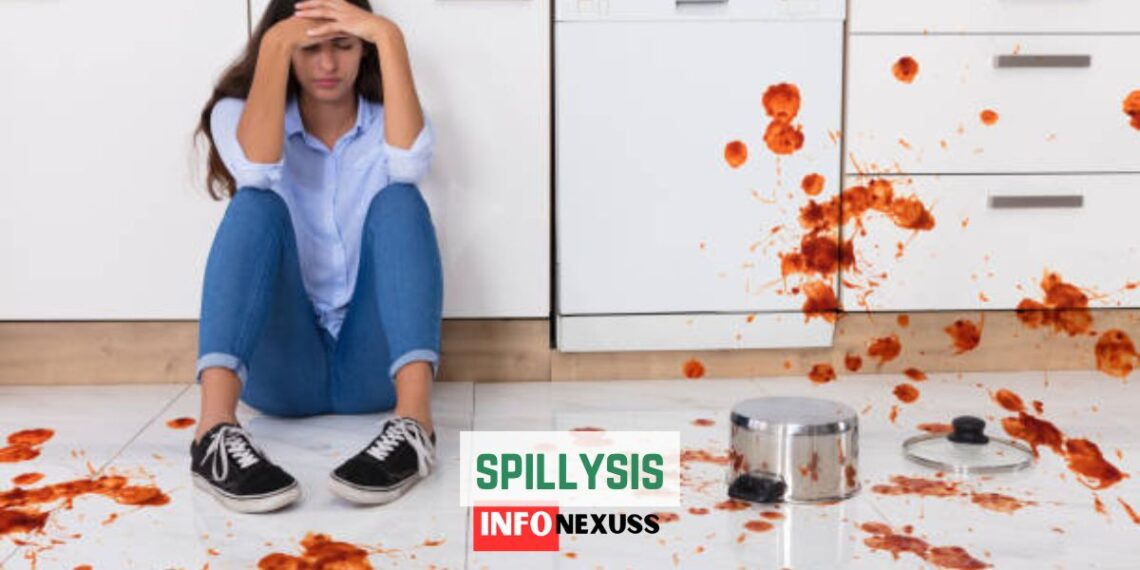
Spillysis: The Silent Threat and Its Impact
Imagine a small, seemingly insignificant spill in your kitchen or workplace. You clean it up, but over time, these minor spills accumulate, leading to unforeseen consequences. This phenomenon, known as “spillysis,” can have significant environmental and health implications.
Spillysis occurs when small spills, often overlooked or improperly cleaned, accumulate over time. These seemingly minor incidents can lead to serious consequences, including:
- Environmental Damage: Chemical spills, oil spills, and other liquid spills can contaminate soil, water bodies, and the surrounding ecosystem.
- Health Risks: Exposure to hazardous substances from spills can lead to respiratory problems, skin irritations, and other health issues.
- Property Damage: Spills can damage property, leading to costly repairs and replacements.
- Regulatory Compliance: Failure to properly manage spills can result in fines and penalties from regulatory agencies.
Table of Contents
The Silent Threat: Understanding the Different Types of Spillysis
Spillysis, the often-overlooked accumulation of small spills, can have significant consequences for both the environment and human health. To effectively address spillysis, it’s crucial to understand the various types of spills that contribute to this phenomenon.
Liquid Spills
Liquid spills are perhaps the most common type of spillysis. They can range from minor water spills to hazardous chemical leaks. Some examples of liquid spills include:
- Chemical Spills: Accidental spills of acids, bases, or other chemicals can lead to environmental damage and health risks.
- Oil Spills: Oil spills, whether from vehicles or industrial facilities, can contaminate water bodies and soil, harming wildlife and ecosystems.
- Cleaning Product Spills: Spills of cleaning products can damage surfaces, create slippery conditions, and release harmful fumes.
Solid Spills
Solid spills, while often less visible, can still pose significant risks. Common types of solid spills include:
- Debris Spills: Spills of debris, such as construction materials, food waste, or packaging materials, can create safety hazards and clutter.
- Dust Spills: Dust particles can accumulate in workplaces and homes, leading to respiratory problems and other health issues.
- Food Spills: Spills of food and beverage products can attract pests and create unsanitary conditions.
Airborne Spills
Airborne spills involve the release of harmful substances into the air, such as:
- Fumes and Gases: Toxic fumes and gases from industrial processes or chemical reactions can pollute the air and pose health risks.
- Dust Particles: Fine dust particles can be released into the air during construction, manufacturing, or other activities, leading to respiratory problems and air pollution.
By understanding the different types of spillysis, individuals and organizations can take proactive measures to prevent and mitigate the risks associated with these incidents.
The Root Causes of Spillysis: Unraveling the Culprits
Understanding the underlying causes of spillysis is crucial in developing effective prevention and response strategies. By identifying these factors, we can take proactive measures to minimize the risk of spills and their associated consequences.
Human Error: A Common Culprit
Human error remains a significant contributor to spill incidents. A lack of training, carelessness, or fatigue can lead to mistakes that result in spills. Some common examples include:
- Improper Handling: Failure to follow proper procedures for handling hazardous materials or other substances can lead to accidental spills.
- Equipment Malfunction: Faulty equipment, such as leaking pipes or damaged containers, can cause spills.
- Poor Housekeeping: Cluttered workspaces and disorganized storage areas can increase the likelihood of spills.
Environmental Factors: The Unexpected Triggers
Environmental factors can also play a role in causing spills. Adverse weather conditions and natural disasters can disrupt operations and increase the risk of accidents. Some examples include:
- Severe Weather Events: Storms, floods, and hurricanes can damage infrastructure and lead to spills of hazardous materials.
- Earthquakes and Natural Disasters: Earthquakes and other natural disasters can cause structural damage, leading to spills of chemicals or other substances.
Lack of Awareness: A Blind Spot in Prevention
A lack of awareness and understanding of spill prevention practices can contribute to the occurrence of spills. This can be particularly problematic in workplaces where employees are not adequately trained or informed about the potential risks and consequences of spills.
By addressing these root causes, individuals and organizations can significantly reduce the risk of spillysis and its associated negative impacts.
The Far-Reaching Consequences of Spillysis
Spillysis, the insidious accumulation of small spills, can lead to a cascade of negative impacts, affecting both the environment and human health. Understanding these consequences is crucial for motivating proactive spill prevention and response measures.
Environmental Damage
One of the most significant impacts of spillysis is environmental damage. When spills, particularly those involving hazardous materials, occur, they can contaminate soil, water bodies, and the surrounding ecosystem.
- Soil Contamination: Spills can seep into the soil, affecting its fertility and the health of plants.
- Water Pollution: Spills that reach water bodies can harm aquatic life, disrupt ecosystems, and contaminate drinking water sources.
- Air Pollution: Airborne spills, such as chemical fumes or dust particles, can contribute to air pollution and respiratory problems.
Health Risks
Exposure to hazardous substances from spills can pose serious health risks to both workers and the general public. Some potential health consequences include:
- Respiratory Problems: Inhalation of toxic fumes or dust particles can lead to respiratory illnesses like asthma, bronchitis, and lung cancer.
- Skin Irritation: Contact with hazardous chemicals can cause skin irritation, burns, and allergic reactions.
- Eye Damage: Splashes of chemicals in the eyes can lead to severe eye damage or blindness.
- Systemic Poisoning: Ingestion or absorption of toxic substances can lead to systemic poisoning, affecting various organs and systems.
Financial Implications
Spillysis can have significant financial implications for individuals, businesses, and communities. Some of the potential costs associated with spills include:
- Clean-up Costs: The cost of cleaning up spills can vary depending on the type and extent of the spill. In some cases, it can be quite expensive.
- Regulatory Fines: Non-compliance with environmental regulations can result in hefty fines and penalties.
- Property Damage: Spills can damage property, leading to costly repairs and replacements.
- Loss of Productivity: Spills can disrupt operations and lead to lost productivity.
- Reputation Damage: A major spill can damage a company’s reputation and lead to loss of customer trust.
By understanding the far-reaching consequences of spillysis, individuals and organizations can take proactive steps to prevent and mitigate spills, protecting both the environment and human health.
Preventing Spillysis: A Proactive Approach
To effectively combat spillysis, a proactive approach is essential. By implementing robust spill prevention strategies, individuals and organizations can significantly reduce the risk of spills and their associated consequences.
Developing a Comprehensive Spill Prevention Plan
A well-structured spill prevention plan is the cornerstone of effective spill management. Key components of such a plan include:
- Hazard Identification: Conduct a thorough assessment of potential spill risks within your facility or workplace. Identify areas where spills are likely to occur and the types of substances involved.
- Spill Containment Measures: Implement physical barriers, such as spill trays, containment dikes, and absorbent materials, to prevent spills from spreading.
- Emergency Response Procedures: Develop detailed procedures for responding to spills, including steps for containment, cleanup, and reporting.
- Employee Training: Train all employees on proper spill prevention and response procedures. Conduct regular training sessions to reinforce knowledge and skills.
- Regular Inspections: Conduct regular inspections of your facility to identify potential hazards and ensure that spill prevention measures are in place and functioning properly.
Promoting a Culture of Spill Prevention
A strong culture of spill prevention can significantly reduce the likelihood of spills occurring. Here are some strategies to promote spill awareness:
- Clear Signage: Post clear signage in areas where spills are likely to occur, reminding employees of spill prevention procedures and emergency contacts.
- Regular Drills: Conduct regular spill drills to test emergency response plans and ensure that employees are prepared to respond effectively.
- Incentivize Safe Practices: Reward employees for following spill prevention procedures and reporting potential hazards.
- Encourage Feedback: Create a culture where employees feel comfortable reporting near-misses and potential hazards.
By prioritizing spill prevention and implementing effective strategies, individuals and organizations can minimize the risk of spillysis and protect the environment.
Managing Spillysis: A Step-by-Step Guide to Effective Response
When a spill occurs, swift and decisive action is crucial to minimize its impact. Here’s a step-by-step guide to effectively manage spillysis:
Immediate Actions: Containing the Spill
- Contain the Spill: The first priority is to prevent the spill from spreading further. Use absorbent materials like spill pads, booms, or sorbents to contain the spill within a defined area.
- Minimize Spread: If the spill is liquid, take steps to prevent it from entering drains or waterways. Cover drains with absorbent materials and isolate the affected area with warning signs or barriers.
- Alert Relevant Authorities: If the spill involves hazardous materials or poses a significant environmental or health risk, notify the appropriate authorities immediately.
- Prioritize Personal Safety: Always prioritize personal safety when responding to a spill. Wear appropriate personal protective equipment (PPE), such as gloves, goggles, and protective clothing, to minimize exposure to hazardous substances.
Also Read: Agile Project Management Of Coffee Internationally In Honduras
Spill Clean-up Strategies
The specific clean-up strategies will depend on the nature of the spill. Here are some general guidelines:
- Liquid Spills: Use absorbent materials like spill pads or sorbents to soak up the liquid. For larger spills, consider using specialized equipment like vacuum trucks or pumps.
- Solid Spills: Sweep up solid spills and dispose of them properly. For hazardous materials, use appropriate cleaning agents and disposal methods.
- Airborne Spills: Ventilate the area to disperse airborne contaminants. Use specialized equipment like air scrubbers or HEPA filters to clean the air.
Proper Disposal
After cleaning up the spill, it’s essential to dispose of contaminated materials properly. Follow local regulations and guidelines for disposing of hazardous materials. Some common disposal methods include:
- Landfill Disposal: Non-hazardous waste can be disposed of in landfills.
- Incineration: Hazardous materials may need to be incinerated to destroy them safely.
- Recycling: Reusable materials, such as metals or plastics, should be recycled.
Documenting the Spill Incident
Documenting the spill incident is crucial for future reference and compliance with regulations. Key information to record includes:
- Date and Time of the Spill
- Location of the Spill
- Type of Substance Spilled
- Quantity Spilled
- Cause of the Spill
- Cleanup Actions Taken
- Personnel Involved
By following these steps and maintaining detailed records, you can effectively manage spillysis and minimize its impact on the environment and human health.
Conclusion
Spillysis, the often-overlooked accumulation of small spills, can have significant environmental and health implications. By understanding the causes and consequences of spillysis, we can take proactive measures to prevent and manage spills effectively.
Human error, equipment malfunctions, and a lack of awareness can all contribute to spill incidents. To mitigate these risks, it’s crucial to implement robust spill prevention plans, including regular training for employees, proper equipment maintenance, and clear spill response procedures.
When a spill occurs, swift and decisive action is essential. By containing the spill, minimizing its spread, and alerting relevant authorities, we can prevent further damage. Proper cleanup techniques, including the use of appropriate cleaning agents and disposal methods, are crucial for mitigating the impact of the spill.
To prevent future spills, it’s important to cultivate a culture of safety and awareness. Regular inspections, clear signage, and ongoing training can help maintain a spill-free environment. Additionally, documenting spill incidents can provide valuable insights for improving future prevention and response efforts.
By taking a proactive approach to spill prevention and response, individuals and organizations can significantly reduce the risk of spillysis and its associated consequences. Remember, even small spills can have big impacts, so it’s essential to prioritize spill prevention and preparedness.
You May Also Like

6 Reasons to Inspect Your Furnace for Winter
November 28, 2024
Jeinz Macias: A Journey of Innovation and Impact
June 5, 2024

